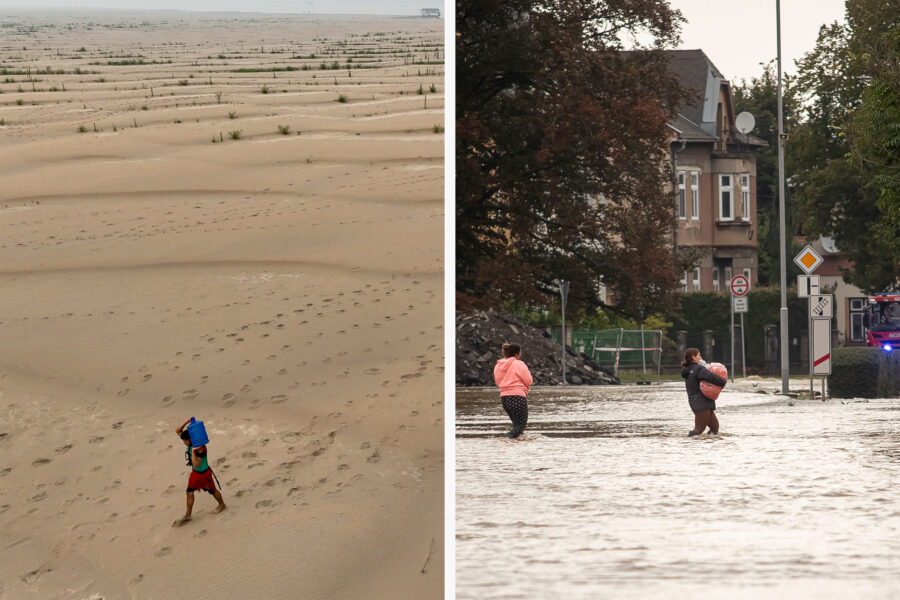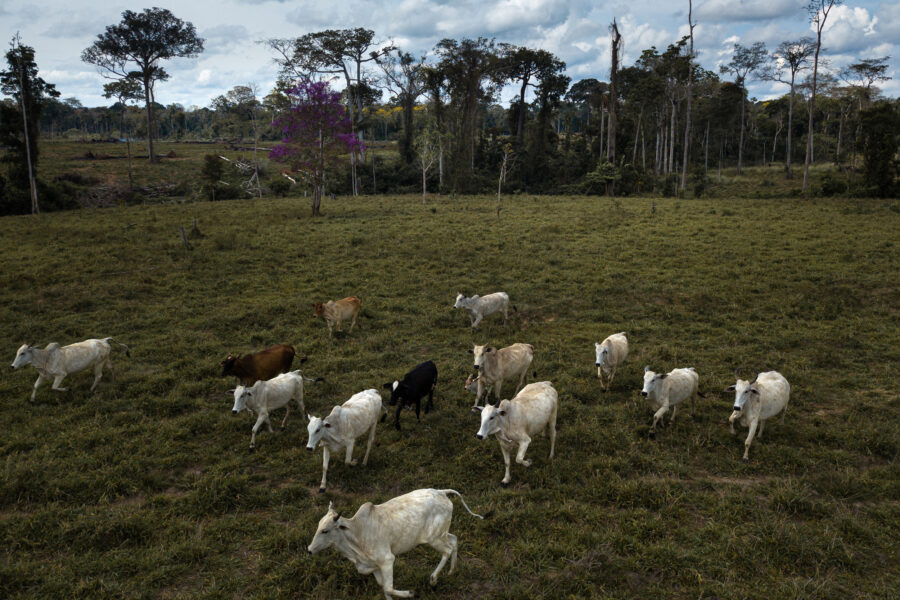Alabama Environmental Group, Fishermen Seek to End ‘Federal Mud Dumping’ in Mobile Bay
For five generations, Avery Bates’ family has worked pulling fish, shrimp, crabs and oysters out of Mobile Bay in south Alabama.
Now Bates fears that his family’s legacy and the oyster reefs they depend on are about to be smothered by the U.S. Army Corps of Engineers.
“Some of them reefs are thousands of years old,” Bates said. “But it don’t take man just a few weeks to destroy it with the mechanical stuff he has now.”
The Corps is three years into a four-year, $366 million project to deepen and widen the Mobile Bay shipping channel to allow for larger cargo ships to reach the port of Mobile.
But the dredging plan also includes dumping most of the 30 million cubic yards of sediment along the sides of the bay, where hundreds of recreational, commercial and charter fishermen ply their trade among Alabama’s last remaining oyster reefs.
Explore the latest news about what’s at stake for the climate during this election season.
Add in 20 years of maintenance dredging, and that’s about 90 million cubic yards of silt that has to go somewhere. Bates and others believe that much mud would bury their way of life.
“This is their job, their livelihood,” Bates said. “Everything that they own, they bought from the water. They caught and worked and sold it to buy their land, their houses, the food they eat, for four or five generations or longer.”
Supporters of the project claim that using thin-layer dispersal throughout the bay, along with some beneficial use projects to combat erosion, is the best solution for disposing of sediment dredged from the channel. The Corps’ environmental assessment says the project “is not projected to have any significant long-term adverse effects.”
Soon its officials might have to justify that in court.
Local environmental group Mobile Baykeeper has teamed up with the Center for Biological Diversity for a Hail Mary attempt to stop the Corps from disposing of silt in the bay.
“At the end of the day, we’re here to protect Mobile Bay, to save the bay and revive it.”
The groups filed a formal notice of intent to sue the Corps over the project, claiming that the dredging will harm the Gulf sturgeon, listed as threatened under the Endangered Species Act.
Even though the project is more than halfway finished, the groups say stopping the mud dispersal in the bay is critical.
“We don’t want to see that mud being dumped in the bay,” Mobile Baykeeper’s Cade Kistler told Inside Climate News.
About a quarter of the sediment being dredged up is going for beneficial use projects like wetlands or shoreline restoration, but Kistler said his group wants to see the rest of the material put farther offshore in the Gulf of Mexico, where it won’t impact oyster reefs or seagrass beds, the bedrock ecosystems that support much of Alabama’s commercial and recreational fishing in the bay.
The Gulf sturgeon—a prehistoric-looking behemoth reaching 9 feet in length and more than 350 pounds—lives in coastal estuaries from about October to April each year before swimming upriver to spawn, returning to the bays over winter.
The sturgeon’s range is described as stretching from Louisiana through the Florida Panhandle, but Mobile Bay was excluded from its critical habitat in its Endangered Species Act listing, which cited a lack of data confirming the existence of a spawning population there.
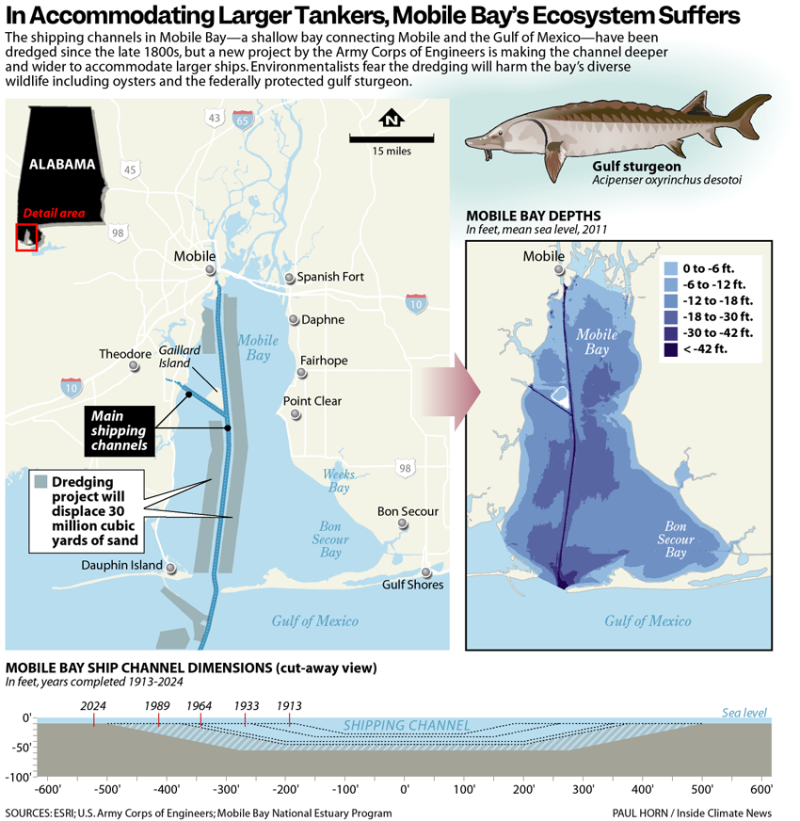
However, the groups contend that the sturgeon does live in Mobile Bay and always has. In their notice of intent, the groups point to a November 2023 study where researchers tagged 210 distinct Gulf sturgeons over six years in Mobile Bay, with records showing they spent around four months a year there.
The groups argue that this new documentation of sturgeons in the bay—published after the planning process was completed—requires the Corps to reevaluate the potential impact of the project on Gulf sturgeon.
In addition to the threat of a lawsuit, the baykeeper has organized town halls packed with angry fishermen who want the dredging stopped, and started an online campaign to “end federal mud dumping” in Mobile Bay.
“At the end of the day, we’re here to protect Mobile Bay, to save the bay and revive it,” Kistler said. “We want seagrass beds and oysters restored, and so we want to make sure that we do what’s necessary to do that.”
Baykeeper’s Claims Disputed
But others say the Mobile Baykeeper is incorrect in its assertion that the Corps’ sediment disposal methods will smother aquatic life.
The Corps told Inside Climate News that of the roughly 30 million cubic yards of sediment that will be dredged over the next year, 8.8 million will be put to beneficial use projects around the bay that promote shoreline stabilization and restoration of sensitive areas around the estuary.
The Corps said it has worked with regulatory agencies including the U.S. Fish and Wildlife Service on the project and it “remains in compliance with all applicable federal and state regulations.”

Alabama State Port Authority Director and CEO John Driscoll sent a letter to Mobile Baykeeper on July 31 to “strongly advise” the group to drop its opposition to the project, calling the possibility of a lawsuit “a direct threat to the State’s largest economic driver, the Port.”
Alabama Gov. Kay Ivey recently touted a study claiming the port has a $98 billion economic impact on the state, directly or indirectly supporting more than 351,000 jobs.
Driscoll wrote that the Corps worked with numerous groups including the Mobile Bay National Estuary Program—a government-created consortium of academia, business, nonprofit groups and other stakeholders to conserve and protect the bay—to determine the best way to handle the dredged material from the channel.
“Unfortunately, Baykeeper, in partnership with an out-of-state activist organization, has defaulted to a combative approach and now threatens to halt a project that has been thoroughly vetted and will bring both environmental and economic benefits to Mobile Bay and our region,” Driscoll said in the letter.
Roberta Swann, director of the Mobile Bay estuary program, co-signed the letter, along with a handful of powerful business groups such as the Business Council of Alabama, Manufacture Alabama and the Mobile Chamber, led by former U.S. Rep. Bradley Byrne.
“Resource agencies have been at the table looking at this issue of sediment management in Mobile Bay for a very long time,” Swann said. “They’re smart people, they’re scientists, they’re engineers. They really are looking at models and whatever data is available to make informed decisions on how to manage the sediment.”
Swann told Inside Climate News that hauling the dredge material offshore would actually be the cheapest option for the Corps, but that has led to problems with coastal erosion in the past.
“It’s a very dynamic system,” Swann said. “So when you dredge that sand that’s supposed to be naturally transporting, naturally moving across Mobile Bay from the top to the bottom, and you dredge it, and you automatically take it offshore, you’re changing the dynamics of that system.”
Property owners on Dauphin Island, a barrier island where Mobile Bay meets the Gulf, sued the Corps in 2000, claiming that pumping sediment offshore was causing erosion and land loss on the island by interrupting the natural flow of sediments from the Mobile Bay watershed into the gulf. That case was settled in 2009, with the Corps agreeing to pay $1.5 million for shore restoration projects on the island.
Responding to concerns about oysters and seagrass, Swann said other factors besides the dredging project play a larger role.
“Those [seagrass beds] are in shallow areas,” she said. “Those seagrasses are dying off because of our development of our coast and the sediment coming out of our coastal watersheds.
“They are not dying off because of some dredging of the ship channel.”
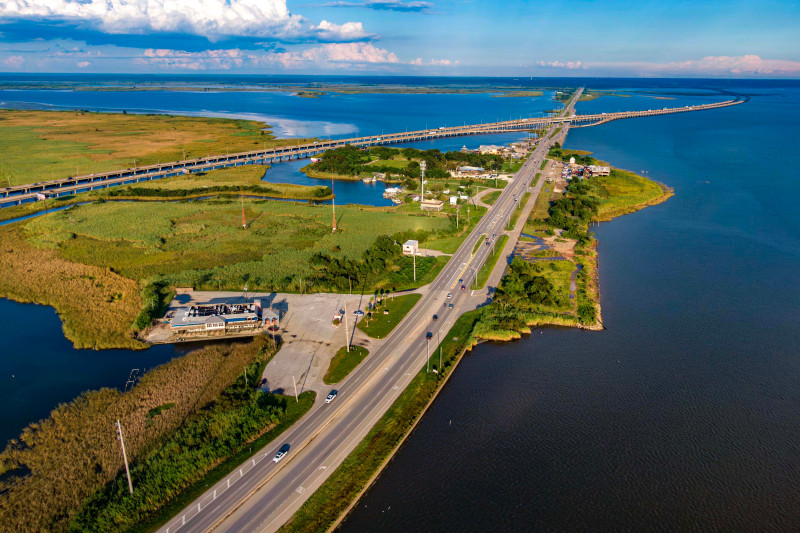
Swann called the Baykeeper’s threat of a lawsuit “frustrating.”
“The frustration becomes, wait a minute, we’re pointing the finger at the port now, because that’s something that we can see,” Swann said. “When, in fact, we really need to be looking at all these factors and what’s our role? What can we do as humans to help manage the complete complexity of all the different variables putting pressure on our oyster populations or our seagrass population?”
Swann pointed to a report prepared for the Mobile Bay National Estuary Program by Thompson Engineering, published Aug. 30, that concluded that adverse impacts from increased silt are likely to be “brief and minor” in the “frequently perturbed system” that is Mobile Bay.
“I think thin-layer placement is a good management practice,” Swann said. “It renourishes our benthic habitats, and any impact that it would have on the critters that live in that benthic area, most of them are very tolerant of stress.
“They’re used to having a lot of sediment movement in Mobile Bay, and based on that report that was given to us, they can rebound from it. There may be short-term impacts, but not long-term impacts.”
Fishermen Feeling the Pinch
That explanation is hard to accept for fishermen who can see the dredge equipment in action.
“Oh, there’s the problem,” charter fishing boat captain Patric Garmeson said in a video posted to social media and shared by Mobile Baykeeper, as he pans from muddy, turbid waters to a dredging platform spewing black mud into the bay.
“There we go, just taking a [expletive] in the bay,” Garmeson said.

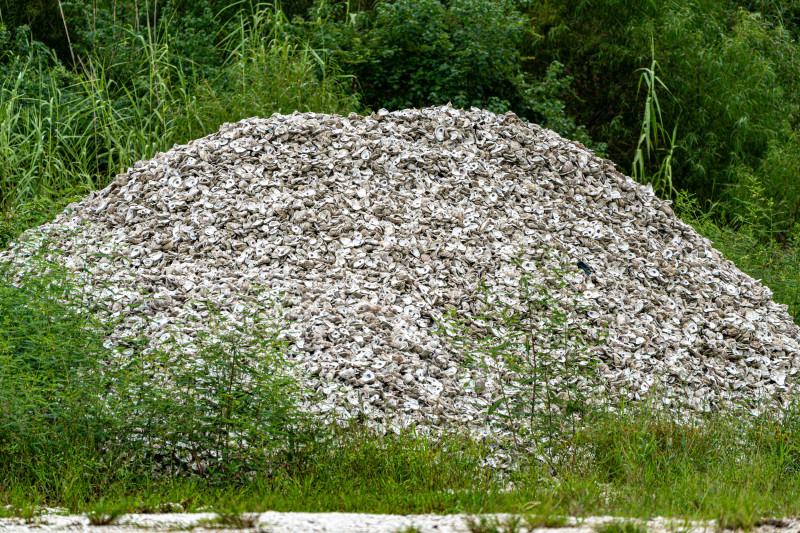
The state’s oyster crop today is a sliver of what it was in generations past, and dropped even further after 2007. Overharvesting, destruction of historic reefs, predation, warming waters due to climate change and silt from the ship channel and from rapid development around coastal Alabama all play a role in the fishery’s decline.
Bates, the semi-retired oysterman who is also chairman of the Organized Seafood Association of Alabama, said the impacts of silt on oysters are well-known.
“Silt covers oysters,” Bates said. “They can’t breathe. It chokes them to death. We’ve seen it time and time again.”
In 2018 the state canceled its wild oyster harvest season altogether because there weren’t enough oysters. Bates said further impacts would leave many of Alabama’s few remaining oystermen in a bind.
“What are people going to do?” Bates said. “Are they going to retrain us to be airplane pilots when we’ve been producing food for people for literally hundreds and hundreds of years?”
The Port’s Role in Coal Imports, Exports
The Alabama State Port is a major artery through which coal, a key contributor to climate change, is sent in and out of the United States.
The port claims to be the largest coal import terminal in the country and the fourth-largest coal export terminal. Coal accounts for 47 percent of all the cargo passing through the port, and petroleum products another 12 percent, according to the Corps.
According to the U.S. Energy Information Administration, nearly 90 percent of the coal mined in Alabama is exported to other countries via the port. And 64 percent of U.S. coal imports come from Colombia, much of that through Mobile. Drummond Co., Colombia’s largest producer of thermal coal, was founded and is still headquartered in Birmingham.

The Alabama Port’s McDuffie Coal Terminal is undergoing $200 million in improvements to handle even higher volumes.
The dredging project is at least partly in response to improvements to the Panama Canal, completed in 2016, that allow larger ships to pass through.
Mobile’s dredging project, once complete, will allow these new “Panamax” ships to reach the port of Mobile, and to have increased maneuvering capability through the shallow bay.
What’s Next?
Kistler said Mobile Baykeeper has continued to have meetings with the Corps in hopes of resolving their concerns.
The Endangered Species Act requires potential citizen plaintiffs to file a notice of intent to sue at least 60 days before filing a lawsuit. Baykeeper and the Center for Biological Diversity filed their notice on July 23, meaning they could file suit by the end of September.
Kistler declined to comment on whether they plan to move forward with the lawsuit, but said his group’s objective is not to sabotage the port or the dredging project. They just want the mud dumped somewhere else.
“We’re not trying to stop the economic development of Mobile, or the port,” Kistler said. “We want to see all that be successful, but we’ve got to do it in a way that also protects our bay.”
About This Story
Perhaps you noticed: This story, like all the news we publish, is free to read. That’s because Inside Climate News is a 501c3 nonprofit organization. We do not charge a subscription fee, lock our news behind a paywall, or clutter our website with ads. We make our news on climate and the environment freely available to you and anyone who wants it.
That’s not all. We also share our news for free with scores of other media organizations around the country. Many of them can’t afford to do environmental journalism of their own. We’ve built bureaus from coast to coast to report local stories, collaborate with local newsrooms and co-publish articles so that this vital work is shared as widely as possible.
Two of us launched ICN in 2007. Six years later we earned a Pulitzer Prize for National Reporting, and now we run the oldest and largest dedicated climate newsroom in the nation. We tell the story in all its complexity. We hold polluters accountable. We expose environmental injustice. We debunk misinformation. We scrutinize solutions and inspire action.
Donations from readers like you fund every aspect of what we do. If you don’t already, will you support our ongoing work, our reporting on the biggest crisis facing our planet, and help us reach even more readers in more places?
Please take a moment to make a tax-deductible donation. Every one of them makes a difference.
Thank you,
David Sassoon
Founder and Publisher
Vernon Loeb
Executive Editor
Share this article
Disclaimer: The copyright of this article belongs to the original author. Reposting this article is solely for the purpose of information dissemination and does not constitute any investment advice. If there is any infringement, please contact us immediately. We will make corrections or deletions as necessary. Thank you.



